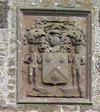| Kirkside House Gatepiers |
|---|

Probably early 19th century. Four ashlar piers, inner piers with eagle finials, outer pair with acorns (according to LBR but they look more like cones to me). category c listed. piers also bear armorial decorations. More Information |
| Stone of Morphie, Alternative Name: Stone Of Morphy |

Stone of Morphie: This standing stone (measuring 1m by 0.7m at the base and 3.4m in height) is immediately S of the public road in the stackyard of Stone of Morphie farm. Traditionally said (New Statistical Account [NSA] 1845) to mark the grave of a son of Camus, killed in a battle between the Scots and the Danes, it was knocked down shortly before 1856. Digging prior to re-erection revealed part of a human skeleton, buried in black unctuous earth. The stone is freestone, and is uninscribed. as ref RCAHMS 1982; J Stuart 1856; Name Book 1863 More Information |
| Various items at Old St.Cyrus cemetry |

Reputed to be the site of a 13th - century kirk, there was said to be no visible signs of its position within the yard though a four-sided structure is present to the rear of the site bearing a carved stone lintel and chamfer-edged doorway. This enclosure, is said to be a burial ground. Built into a corner of the kirkyard is a small old watch-house with a good secure door and a small watch window. |
This content was submitted by external contributors and does not necessarily reflect the views of the University of Aberdeen.
